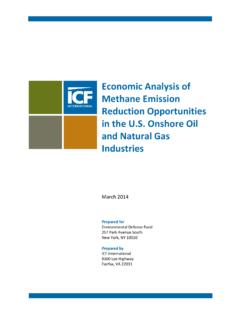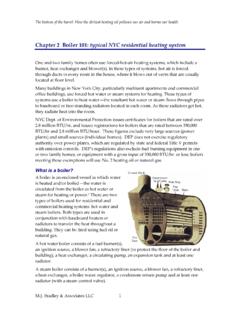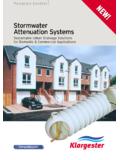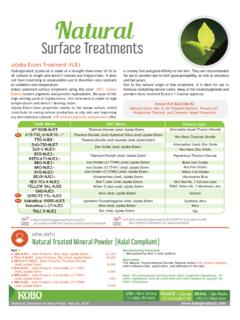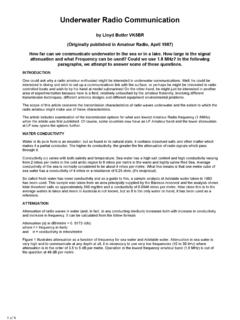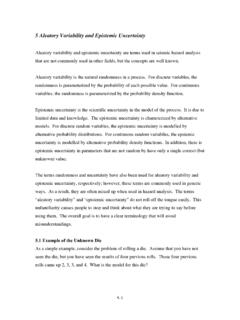Transcription of Performance of Natural Infrastructure and Nature-based ...
1 Performance of Natural Infrastructure and Nature-based Measures as Coastal Risk Reduction Features Authors Shannon Cunniff1. and Aaron Schwartz2. September 2015. 1. 2. Introduction The Environmental Defense Fund (EDF) aims to improve the ability of coastal communities to reduce risks from sea level rise and coastal storms through the use of Natural Infrastructure and Nature-based measures. Recognizing that better quantification of the storm risk reduction benefits of these approaches is necessary to help decision-makers choose among alternatives to protect their communities, as well as help to develop new market-based or private sector funding options for Natural Infrastructure and Nature-based measures, this paper presents a review of the state of knowledge on the Performance of these approaches, compiled from existing literature and participant input obtained during an EDF-convened expert workshop in May 2015.
2 This EDF report represents the review of the state of knowledge on the Performance of Natural and Nature-based Infrastructure as compiled from existing literature and participant input obtained during an expert workshop. Table 1 provides an accessible summary of the most current state of understanding of the risk reduction Performance of Natural Infrastructure . It is important to note that, while absent from the Table 1, non-structural approaches, such as zoning, building codes and evacuation planning, play critical roles in increasing coastal resilience. Sutton-Grier et al. (2015) highlight the strength and weaknesses of the coastal protection benefits provided by traditional built Infrastructure , Natural ecosystems, and combinations of built and Natural Infrastructure solutions.
3 Improved resiliency to coastal storms requires careful consideration of this full suite of tools. Background and Methods In May 2015, EDF brought together nineteen scientists, engineers, program managers, and financiers for a workshop to discuss establishing disaster risk reduction and climate adaptation Performance of Natural Infrastructure and Nature-based measures for coastal communities. See Table 2 for a list of participants. EDF's goals for the workshop were to: Inform EDF's plans to advance the effective use of Natural Infrastructure and Nature-based solutions in reducing risks from coastal storms and sea level rise; and Connect decision-makers with the research community to encourage an exchange about current knowledge, as well as identify where additional research is needed, about the Performance of Natural Infrastructure and Nature-based measures.
4 Prior to the workshop EDF developed and provided to invited workshop participants a draft of Table 1 and a literature review regarding the Performance of the following Natural and nature- based measures. The literature review focused on the risk reduction Performance , including attention to uncertainties regarding each measure's ability to keep pace with anticipated sea level rise and mitigate climate change by sequestering carbon. The review also identified outstanding research questions. EDF asked workshop participants to provide input to expand, amend or otherwise refine the literature review and summary table. Over the course of the workshop, EDF asked participants to identify the kinds of information needed to establish the risk reduction Performance of Natural Infrastructure and Nature-based measures and the conditions affecting their reliability.
5 EDF also asked workshop participants to identify other opportunities and challenges to scaling up each measure's adoption, including 2. research needs to develop, refine, or improve understanding of risk reduction Performance and development of design criteria as well as policy and practice needs. Participants were asked to identify and prioritize research needs based on which were most pressing or would catalyze broader and more rapid acceptance of Natural Infrastructure and Nature-based measures. Following the workshop, EDF supplemented the literature review with key points raised during workshop discussions. Items lacking citations represent the oral communications of workshop participants. EDF provided workshop participants, and other external experts1, a revised literature review for additional comment.
6 This final version represents EDF's incorporation of those additional comments. Findings _____. BEACH NOURISHMENT. _____. Methods of risk reduction Breaking of offshore waves. (USACE, 2013). Attenuation of wave energy. (USACE, 2013). Beaches, when combined with sand dunes, reduce the risks of storm surge related wave attack and flooding on barrier islands and the mainland. (NRC, 2014). Method strengths Reduces erosion, flooding, and wave attack and may reduce the likelihood of forming new inlets. (NRC, 2014). An increase in the sediment budget downdrift of fill areas enhances the likelihood for landforms to evolve, increasing topographic diversity in a way that is more Natural than by direct nourishment. (NRC, 2014). Beachfill might protect not only the beach where it is placed, but also downdrift stretches by providing an updrift point source of sand.
7 (USACE, 2006). Coastal risk reduction projects can be designed to provide increased ecological value. (NRC, 2014). Known weaknesses Requires periodic to continual sand resources for renourishment. Can be eroded by extreme event surge and waves; no high water protection. Possible impacts to regional sediment transport. Can lead to removal of large volumes of offshore sand. (NRC, 2014). Does not address back-bay flooding. (NRC, 2014). Even though beach nourishment is generally considered as an environment-friendly option for coastal protection and beach restoration, sizeable impacts on several beach ecosystem components (microphytobenthos, vascular plants, terrestrial arthropods, 1. The additional external experts are listed in Table 2. 3. marine zoobenthos and avifauna) can occur.
8 (Speybroeck et al., 2006) The projects may may cause undesirable side effects, including ecological impacts on offshore dredging sites and unnatural sand/sediment types at project sites. Can lead to steeper beach profiles, which can increase wave energy on the beach, increase beachside erosion, and preclude wave overwash. (Green, 2002). The lifetime of beach nourishment projects are often short, and beaches may need to be re-nourished frequently. Uncertainties about utility for risk reduction & resilience The level of risk reduction afforded by a beach nourishment project varies over time, as the beach and dune are eroded by Natural processes, requiring periodic renourishment (varying by location). (NRC, 2014). Unpredictable lifetime: storm history is the most important factor in determining beach durability.
9 Beach length, grain size, shoreface slope, shelf width and method of fill emplacement show no correlation to regional replenished beach lifetime. (Leonard et al., 1990). Erosional hot spots may develop from a variety of causes, including material source and the presence of adjacent structural measures. (Kraus and Galgano, 2001). There are several recognized failure modes for beach fills (USACE, 2006): o Failure to protect upland property or structures during storm events. o Movement of fill material to undesired locations, such as into inlets or harbors. o Loss of fill material at a rate greater than anticipated for some reason other than design wave exceedance. Suitable Conditions Most: o Low-lying oceanfront areas with existing sources of sand and sediment.
10 Least: o Not generally well-suited for application to most major urban centers or areas with large port and harbor facilities because of the space requirements and the level of risk reduction desired. (NRC, 2014). o Not suited where no local source of beach fill exists. Performance factors/ Performance evaluation metrics/Design metrics Part of the design process is estimating how long the beach fill will serve its function under typical wave conditions. (USACE, 2006). o Such estimates are difficult, at best, because of wave climate uncertainty and the complexity of beach fill response to storm conditions. (USACE, 2006). o A new project may suffer a severe storm immediately upon completion, resulting in massive fill losses, or the beach fill may serve for many years without ever being exposed to design storm conditions.
